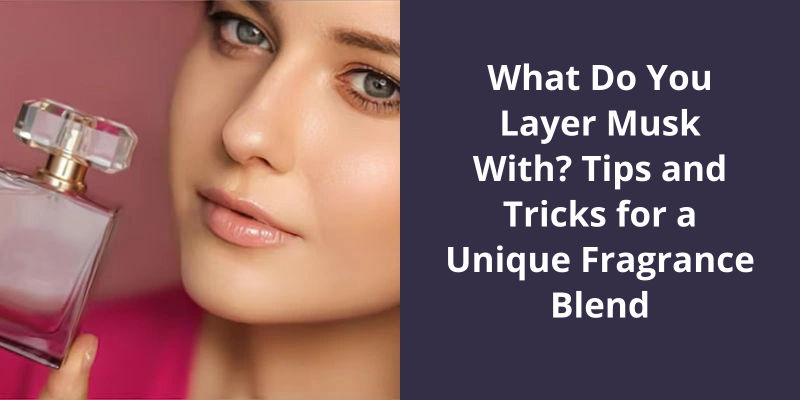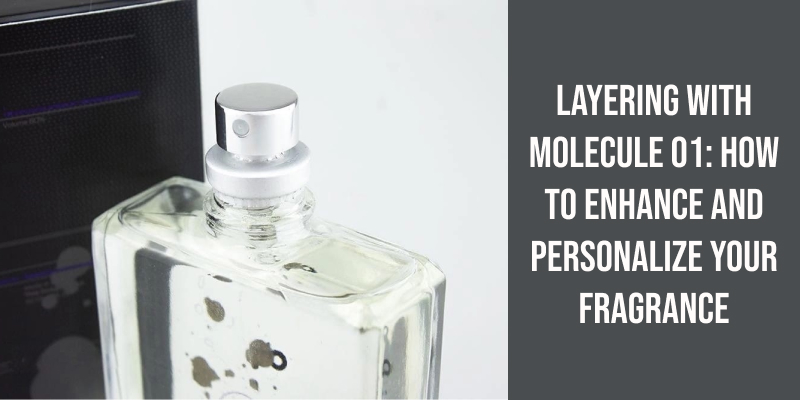Layering musk in perfume often involves pairing it with floral scents like rose, jasmine, or lavender to create a harmonious balance. This combination tends to bring out the sweetness in the musk while taming its heaviness. You can also blend musk with citrus notes like lemon, orange, or bergamot for a fresh and lively scent, making it a little bit lighter and brighter. Woody scents like sandalwood or cedarwood can also be paired with musk for a deeper and more sensual fragrance. To add a touch of refreshing and soothing fragrance, layer musk with mint or eucalyptus. By experimenting with these unique combinations, you can create a signature scent that suits your personal style and preference.

What Layers Go Well With Musk?
Start with a light, fresh scent as the base, such as a citrus or floral scent. This will provide a light, clean scent to build upon. Next, add in a musk scent, which will provide a rich, warm scent to the fragrance. This combination creates a balanced scent that’s neither too heavy nor too light.
For a more earthy and masculine fragrance, try layering musk with scents like cedarwood, vetiver, or patchouli. These types of scents will add depth and intensity to the fragrance, making it perfect for evening wear or a night out on the town.
If you prefer something a bit sweeter, try layering musk with vanilla or honey scents.
When it comes to creating your own fragrance, it’s important to experiment and try different scent combinations. You never know what type of fragrance you might end up creating. Whether you prefer a light and airy scent or something a bit heavier and more intense, musk is a versatile fragrance that can be layered to create a scent that’s uniquely you.
Different Types of Musk (Ambrette, White Musk, Black Musk, Etc.) and Their Unique Characteristics
- Ambrette musk: Has a sweet, floral scent with earthy undertones and is used in perfumes and colognes.
- White musk: Has a clean, powdery scent and can be found in fragrances, soaps, and skincare products.
- Black musk: Has a deep, musky scent with hints of sweetness and is often used in niche fragrances and perfumes.
- Deer musk: Made from the gland of male deer and has a strong, animalistic scent. It’s now banned due to animal cruelty concerns.
- Tonkin musk: Comes from the muskrat and has a strong, earthy scent and is used in traditional fragrances.
- Civet musk: Comes from the African civet cat and has a sweet, musky scent. It’s now banned due to animal cruelty concerns.
Musk is considered one of the most popular and sensual scents used in perfumes. It’s inviting and warm aroma adds a touch of romance, which makes it a common base note in many fragrances. In the following sections, we’ll explore the history of musk, it’s uses, and how it’s evolved over time.
Is Musk a Sensual Scent?
Musk has been used in perfumery for centuries and is derive from the musk deer. This synthetic version has the same warm and sensual qualities as the natural musk, but it’s more sustainable.
The sensuality of musk is due to it’s close proximity to the skin. It smells similar to human pheromones – the chemicals that attract others on a subconscious level. It’s said to enhance the wearers natural scent, making it even more alluring to those around them.
There are many variations of musk used in perfumes, including white musk, black musk, and red musk. Each has it’s own unique scent profile, but all share the same warmth and sensuality that’s so appealing. Some scents with musk as the dominant note include Narciso Rodriguez for Her, Tom Fords Velvet Orchid, and Yves Saint Laurents Opium.
Widely used in perfumery, it’s often the base note, providing depth and staying power to fragrances.
The Sensory Experience of Wearing Musk-Based Fragrances and It’s Effect on Mood and Emotions.
- Increased self-confidence
- Heightened sense of attraction
- Improvement in mood
- Greater sense of well-being
- Enhanced memory retention
- Elevated focus and concentration
- Reduced stress levels
- Boost in energy levels
Source: A Guide to Musk Perfumes and Scents: Musk Notes – Lancome
Now that we know about the substitute for animal derived musk oil, it’s time to delve deeper into the world of essential oils. Choosing the right essential oil can make all the difference in the overall aroma and benefits of a product. So, let’s explore some other essential oils that pair well with musk to create a unique and pleasing fragrance.
What Essential Oil Goes With Musk?
Essential oils are a commonly used natural fragrance that can be used in various products such as perfumes and candles. One popular scent that many people love is musk. However, for those who wish to avoid animal products, traditional musk oil isn’t a viable option. Luckily, there’s a natural alternative, Ambrette Seed or Musk Ambrette.
Musk Ambrette is derived from the seeds of the Abelmoschus Moschatus plant, which is native to India. The plant produces small, yellow flowers that have a sweet fragrance. The seeds are extracted and distilled in order to create the essential oil. Musk Ambrette has a musky, woody scent that’s similar to traditional musk oil, making it a great substitute for those who prefer cruelty-free options.
When using Musk Ambrette essential oil, it’s important to remember that a little goes a long way. It’s a highly concentrated oil that should be diluted before use. Additionally, it isn’t recommended to use essential oils directly on your skin, as they can cause irritation or allergic reactions.
It’s earthy and musky scent blends well with a variety of essential oils, giving you the ability to create a personalized fragrance that fits your preferences. Always remember to use essential oils with caution and consult a healthcare professional if you’ve any concerns.
How to Make a DIY Musk-Scented Perfume Using Musk Ambrette and Other Essential Oils
To make a DIY musk-scented perfume, you can use musk ambrette and other essential oils. Combine the oils in a small bottle, shake well, and let it sit for a few days to allow the fragrances to blend. Adjust the proportions of oils to get your desired scent strength, and use a carrier oil to dilute the mixture if necessary.
Conclusion
While there’s no one-size-fits-all formula for layering fragrances, it’s generally recommended to start with a base note and build up with complementary scents. Ultimately, the key to successful layering lies in experimenting and finding what works for you, so don't be afraid to mix and match until you find your perfect scent combination.





